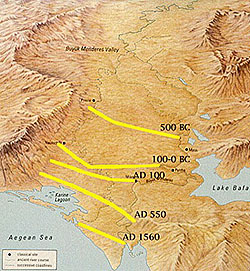 Agriculture has, unfortunately, a tendency to degrade the soil in several ways. The elaborate preparation of a seed bed--plowing or digging up the soil in preparation for planting--exposes the soil to wind and rain and makes it more susceptible to erosion. This susceptibility is increased if the soil is left without plant cover for a long period of time each year.
Agriculture has, unfortunately, a tendency to degrade the soil in several ways. The elaborate preparation of a seed bed--plowing or digging up the soil in preparation for planting--exposes the soil to wind and rain and makes it more susceptible to erosion. This susceptibility is increased if the soil is left without plant cover for a long period of time each year.The illustration at left shows the effects of erosion due to intense agricultural use in ancient times on the Menderes Valley in what is now Turkey. The soil washed downstream from agricultural lands pushed the delta of the Menderes dramatically out into the Aegean Sea. This process of soil erosion was aggravated by deforestation of the slopes of the watershed. Intact forest lands absorb water well even on steep slopes. However, steep slopes tend to degrade quickly once the forest cover is removed by timber-cutting, burning, or over-grazing by domestic animals.
Overgrazing by domestic animals is another cause of degradation of the environment. Overgrazing of semi-arid lands is particularly disastrous, as it may result in desertification--the degradation of marginal lands into true desert. Much of the present desert lands of the world are man-made. Many of the areas that once supported great civilizations and large human populations are now barren wastes.